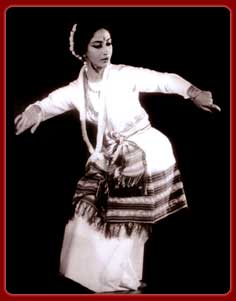Manipuri dance
Manipuri dance is one of the major Indian classical dance forms. It originates from Manipur, a state in north-eastern India on the border with Myanmar (also known as Burma).
History

It was originally only performed in temples and continues to form an integral part of the religious and social fabric of Manipur. Manipuri dance, whether folk, classical or modern, is devotional in nature. The people of Manipur are very religious and are exclusively attached to the Hindu deities Radha and Krishna, who are often the main characters depicted in Manipuri dances. Ras Lila is one such Manipuri dance.
It is only since the early 20th century that Manipuri dance has been presented on stage. It became better known outside the region through the efforts of Rabindranath Tagore, the Bengali poet and philosopher who won the Nobel Prize for Literature in 1913. He fell in love with the dance when he first saw it in 1920.
Tagore brought Manipuri dance teachers to the university created by him in Santiniketan (150km north of Kolkata). Today, traditional Manipuri dance continues to be taught in Santiniketan, as it is in Manipur and Delhi.
Steps
The traditional Manipuri dance style embodies delicate, lyrical and graceful movements. The aim is to make rounded movements and avoid any jerks, sharp edges or straight lines. It is this which gives Manipuri dance its undulating and soft appearance. Of course, behind this outwardly soft impression lies a tough regime of body control.

In contrast with other Indian dance forms, the dancerís feet should never strike the ground hard as this would interfere with the delicate flow of the body movements. Every time the dancer puts down his or her feet, even during vigorous steps, it is the front part of the feet which touch the ground first and Ďbreak the fallí. The ankle and knee joints are effectively used as shock absorbers.
The dancerís feet are neither put down nor lifted up at the precise rhythmic points of the music but rather slightly earlier or later to express the same rhythmic points most effectively. This is possible because the way the feet move is viewed as a part of a composite movement of the whole body. Indeed, Manipuri dancers do not wear ankle bells, whose purpose in other Indian dances is to accentuate the beats tapped out by the feet.
Like the movements of the body and feet, the facial expressions in Manipuri dance should be subtle. The main bases of this dance style are devotion and grace.
The musical accompaniment for Manipuri dance comes from a percussion instrument called the Pung, a singer, small cymbals, a stringed instrument called the pena and wind instrument such as a flute. The drummers are always male artistes and, after learning to play the pung, students are trained to dance with it while drumming. This dance is known as Pung cholom.
Manipuri dance has had a very different evolution from other Indian classical dances. With its origins in Manipur, which is surrounded by mountain ranges and geographically isolated at the meeting point of the orient and mainland India, Manipuri dance developed its own specific aesthetics, values, conventions and ethics.
Manipur | Links | Resources | Add Link